What exactly are you looking at when you examine a horse feed tag? There can be a lot of numbers, but the first three are big ones to determine the type of horse they are suited for. These three are the macronutrients – the nutrients required in the horses diet in larger amounts than the trace minerals and vitamins (micronutrients). We’ve previously discussed the benefits of organic form trace minerals in the equine diet and have done a broad overview of horse requirements. In this blog we will dive deeper into the “big three” items to look for to determine if it’s an appropriate choice for your horse. Most commercial feeds are formulated with adequate trace minerals when fed to tag requirements, so focusing on macronutrient needs of your individual horse can help determine where to start on your search for a feed to fit your horses.
Protein
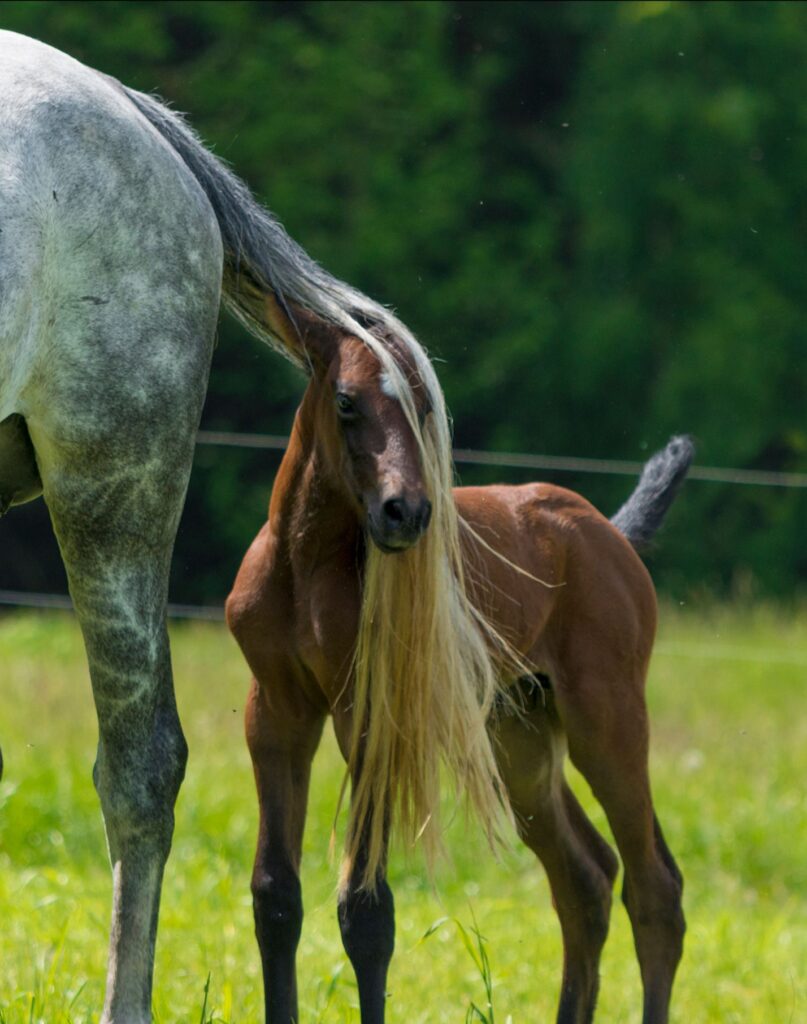
Depending on the growing season, it is sometimes the case that good quality hay is able to provide sufficient protein for maintenance in the mature, inactive horse. However, for those horses who are in demanding life stages (growing, lactating, breeding) or are engaged in a wide range of performance activities or exercise, added protein to the diet is required. Protein provides a small amount of energy to the horse, although the main function is providing an array of amino acids absorbed through the small intestine that are the building blocks of muscles, bones and tissues. This is important not only to the growing horse for proper development but also to the riding and performance horse to encourage tissue and muscle repair.
The quality of the protein provided is more important than the crude amount. Different sources of protein provide a different amino acid profile (for example, corn versus alfalfa) – some which are more diverse and therefore of more quality than others. The effectiveness of protein is only as good as the first limiting amino acid. Horses are unable to make all of the required amino acids themselves and therefore certain “essential amino acids” are necessary to provide in their diet. If one essential amino acid is limited, the horse cannot make proper use of any amino acids in their body. Lysine is consistently one of the most limiting amino acids, followed by methionine and threonine. Added lysine is often an ingredient of commercially formulated horse feeds.
A variety of ingredients in horse feedstuffs contain varying amounts of protein that are diverse in quantity and quality. Cereal grains, hay and pasture all contribute protein in the equine diet. For high quality added protein sources look for legumes such as soybean or seed meals (canola, as an example). Legumes in your hay will also contain quality protein sources (alfalfa is a good example here). The inactive horse can do well on feeds with a lower protein content, while those more active or in high energy life stages should shoot for a higher crude protein of 12% or above.
Fat
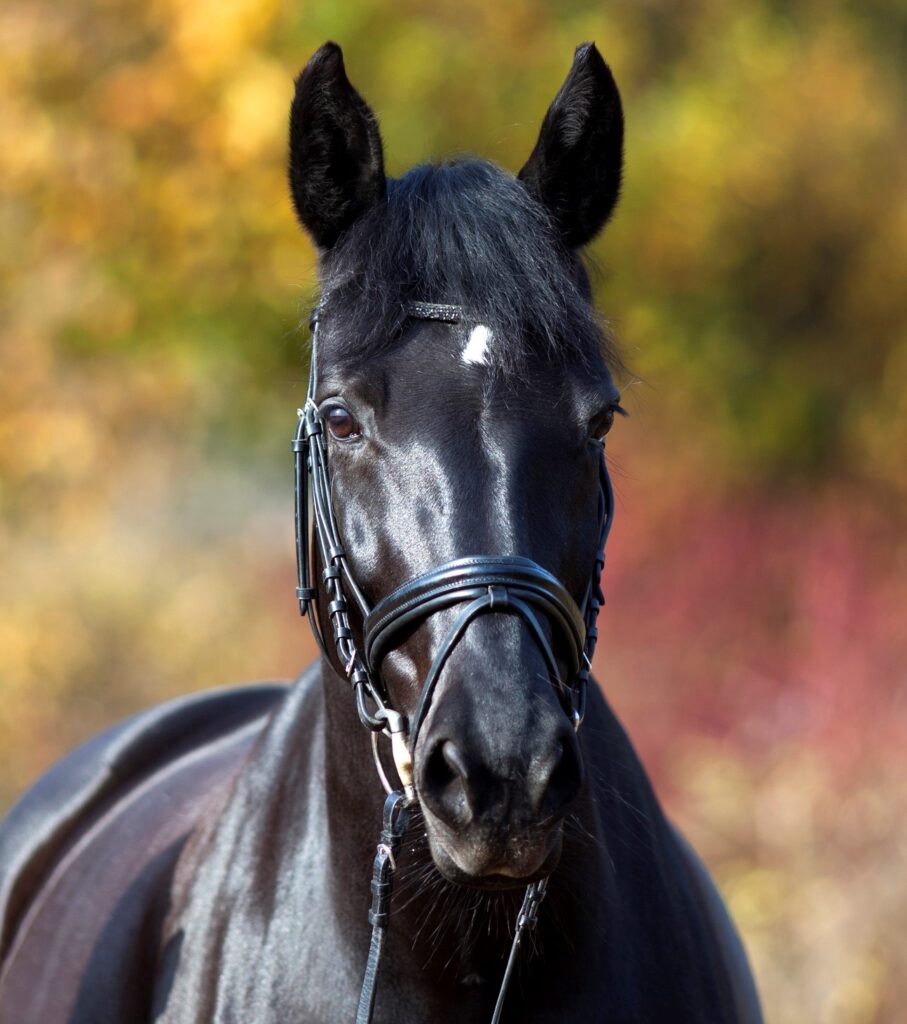
In stark contrast to what we usually think in relation to human diets, high fat diets for equines are becoming increasingly more common as potential benefits are reported by the scientific community. Adding fat sources to equine diets has been shown to be advantageous in providing energy to the working horse without the risks associated with elevated starches. Although high starch is still a valuable diet for the quick working athlete, fat has become increasingly popular as a “cooler”, more dense energy source for the moderate athlete or in disciplines where excess energy is undesirable. Fat has almost twice the amount of energy than carbohydrates while also contributing to weight gain and coat shine. This is in addition to playing a significant role in the absorption of fat-soluble vitamins.
Like protein, fat is made up of various chains of fatty acids, some of which are essential while others are not. These fatty acids are absorbed and used as an energy source to fuel muscle contraction and metabolic processes and can also be stored in the horse for future energy needs. Similar to protein, different sources of fat provide different chains of fatty acids with varying qualities. Interest in the anti-inflammatory properties of fat sources in potentially combating equine joint disease has put a spotlight on fat sources that contain omega-3 – these include flaxseed, canola, and soybean oils and even fresh pasture.
In general there are usually low levels of fat in forages, so fat sources are often supplemented into the equine diet through commercial feeds or additives. This energy source doubles in it’s benefits when taking into consideration the potential positives in long term intestinal health that could coincide with decreased starch energy in the diet. Horses can tolerate large amounts of fat in their diet (up to 20%) compared to starch, but as with any ingredient, too much could also prove detrimental. There is the potential for too much fat in the diet to interfere with microbial fermentation in the hindgut if consistently passed through the small intestine undigested.
Also of note is that equine obesity is becoming more of a welfare issue than ever before. A high fat diet for a horse who is already over-conditioned can be further detrimental to their overall health. For maintenance horses or easy keepers, try to look for a product that has lower fat (around 3-5%) on the tag. For harder keepers or intense athletes, high fat (8% or higher) and fibre products provide cool working energy and necessary calories.
Carbohydrates

Carbohydrates can be broken down into two categories, structural and non-structural (NSC). Structural carbohydrates are the plant wall structure of forage that horses consume, otherwise known as fibre. This component of the plant is broken down by microbial fermentation in the hindgut. Horses get a large quantity of their daily energy needs from cellulolytic bacteria breaking down structural carbohydrates which is partly why long stem forage is such a crucial part of the equine diet. The other part of the plant, the insides, are what are called non-structural carbohydrates or NSC. This component is made up of simple sugars and starch that are digested primarily in the stomach and small intestine.
NSC has gotten a lot of research attention for it’s potential to overload – if NSC is not digested in the small intestine and reaches the microbial fermentation vat, there is potential for digestive disturbances and there is some evidence suggested that long term high starch diets leave horses at risk for certain metabolic diseases. However, it is important to note that amongst all the buzz about NSC, there are benefits and caveats to consider when feeding. NSCs are very important to the high performance horse – they provide glycogen for intense, fast work. Some horses require starch for this glycogen replenishment such as high speed or multi-day events. It is also important to note that the NSC percentage is not indicative of the total weight the horse is eating per day; the entire diet needs to be taken into consideration to find out the approximate value of sugar and starch a horse is receiving. A “high” NSC feed may not actually contribute much in NSC value to the overall diet when fed at 5lbs per day, while hay is fed at 15-20lbs.
In order to determine what level of sugar you should select for your horse, it is first best to know what levels of sugars are in your hay. In general, older, more mature hay will have more structural carbohydrates (fibrous energy) while less mature, greener forage will likely have more non-structural carbohydrates. For those who have concerns in regards to sugars (insulin resistance, Cushing’s, PSSM, etc.), look for products that are fat and fibre. These types of concentrates pull energy sources from fat, as described above, and structural carbohydrates (fibre). If your horse is already overweight, opt to work in a ration balancer that is low fat. Although it may be a “higher” NSC than a low, due to it’s low feed rate in the diet, it is likely to also be low in sugars and starches while also not adding any weight to an already heavy horse.
Taking a look at the “big three” macronutrients on a feed label can help to determine which type of horse and at which life stage it is appropriate for. When in doubt, our Masterfeeds equine representatives are always here to help customize a program for your herd. Check out some of our go-to featured products that cater to specific needs for a happy, healthy horse, below!
For more information or to schedule an on-farm call or hay analysis from one of our reps, visit our website, contact us, or email us directly at: happyhorses@masterfeeds.com
Product Spotlight
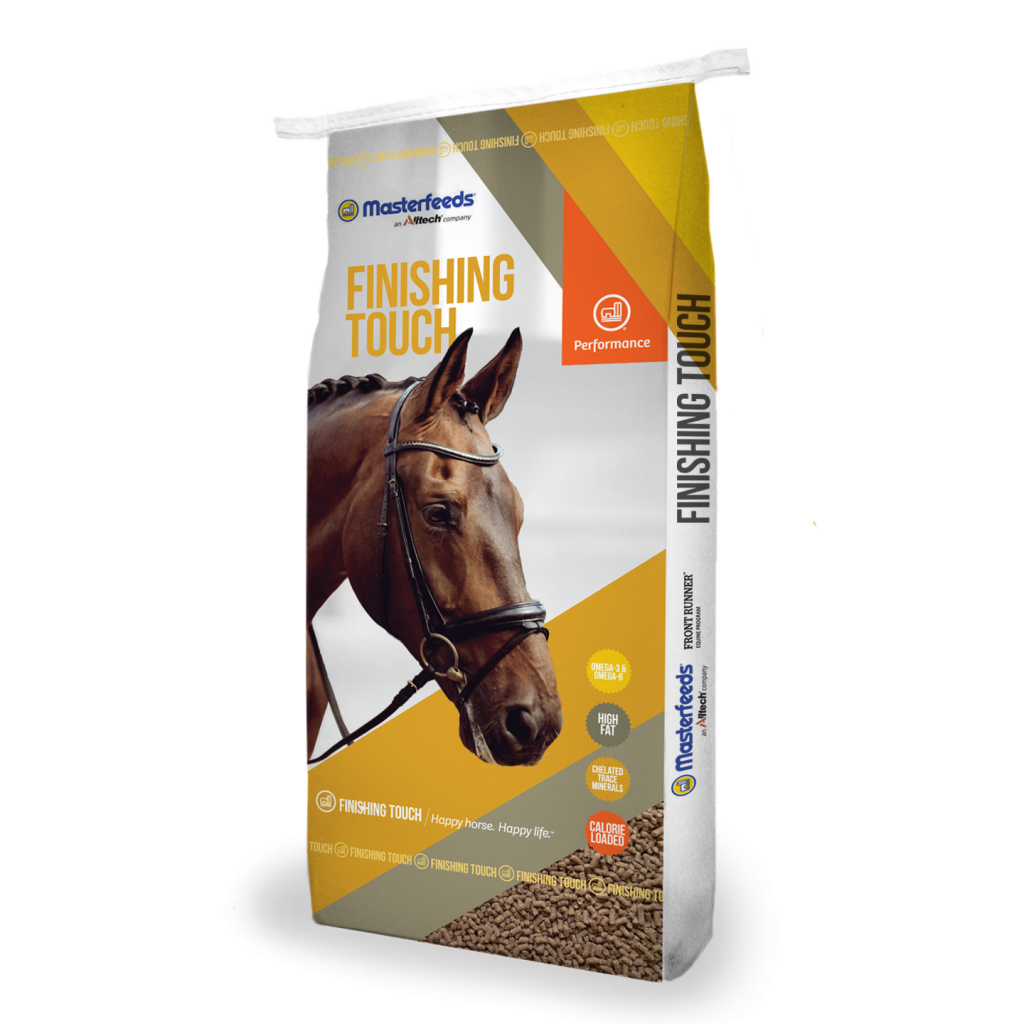
FINISHING TOUCH (CRUMB) EAST | WEST
FOR IMPROVED PERFORMANCE, WEIGHT GAIN & COAT CONDITION
Finishing Touch is a smart energy addition to any developmental diet. This high protein, high fat supplement is designed to be topdressed on a balanced complete feed to increase the caloric density of the diet. It is an excellent choice for extra fit and finish on sale and show stock and for enhancing fertility during breeding season for both mares and stallions.
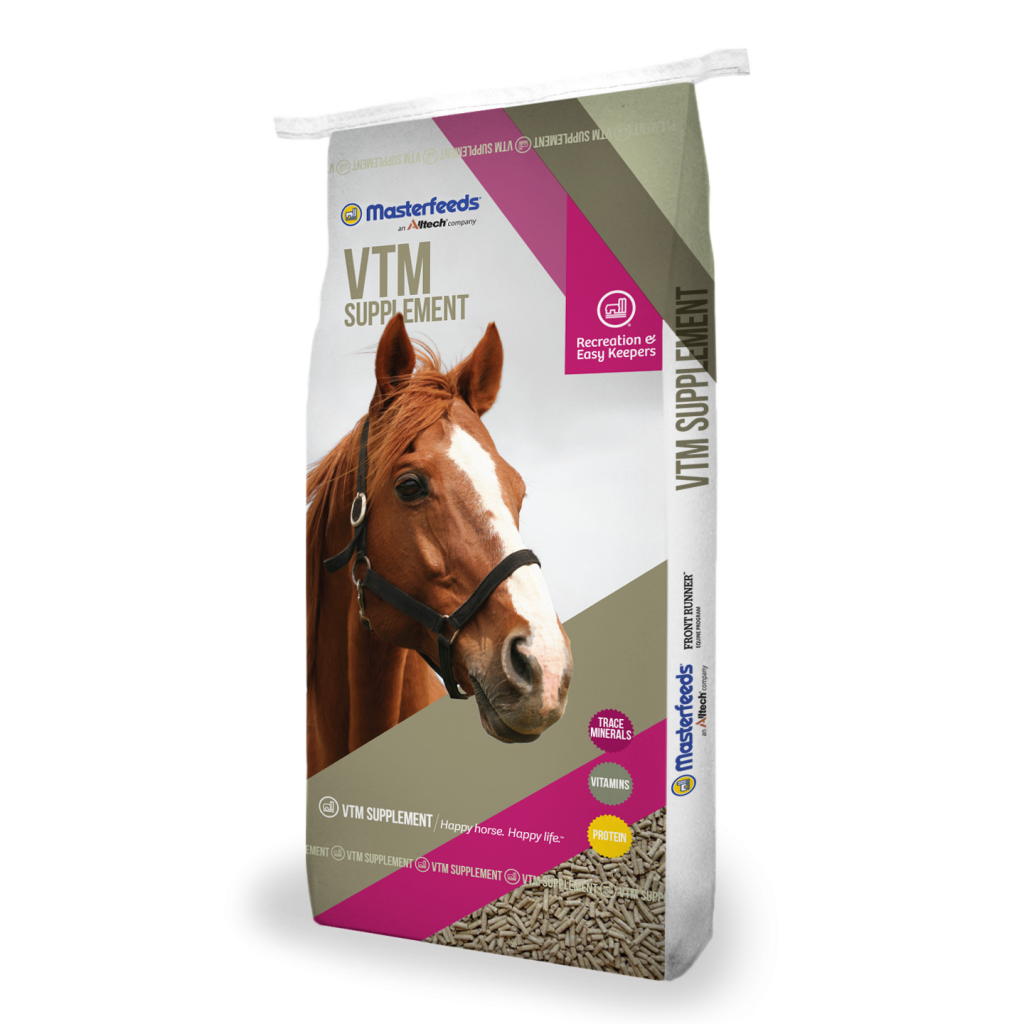
VITAMIN/MINERAL SUPPLEMENT (PELLET) EAST | WEST
FOR ALL CLASSES OF HORSES WHEN EXTRA NUTRIENTS ARE NEEDED
VTM is a trace mineral and vitamin supplement with elevated protein. It can be mixed with grains to make your own ration or top dressed on complete feeds to add additional minerals, vitamins and protein. Very palatable and versatile, it’s a great choice for all classes of horses when extra nutrients are required.
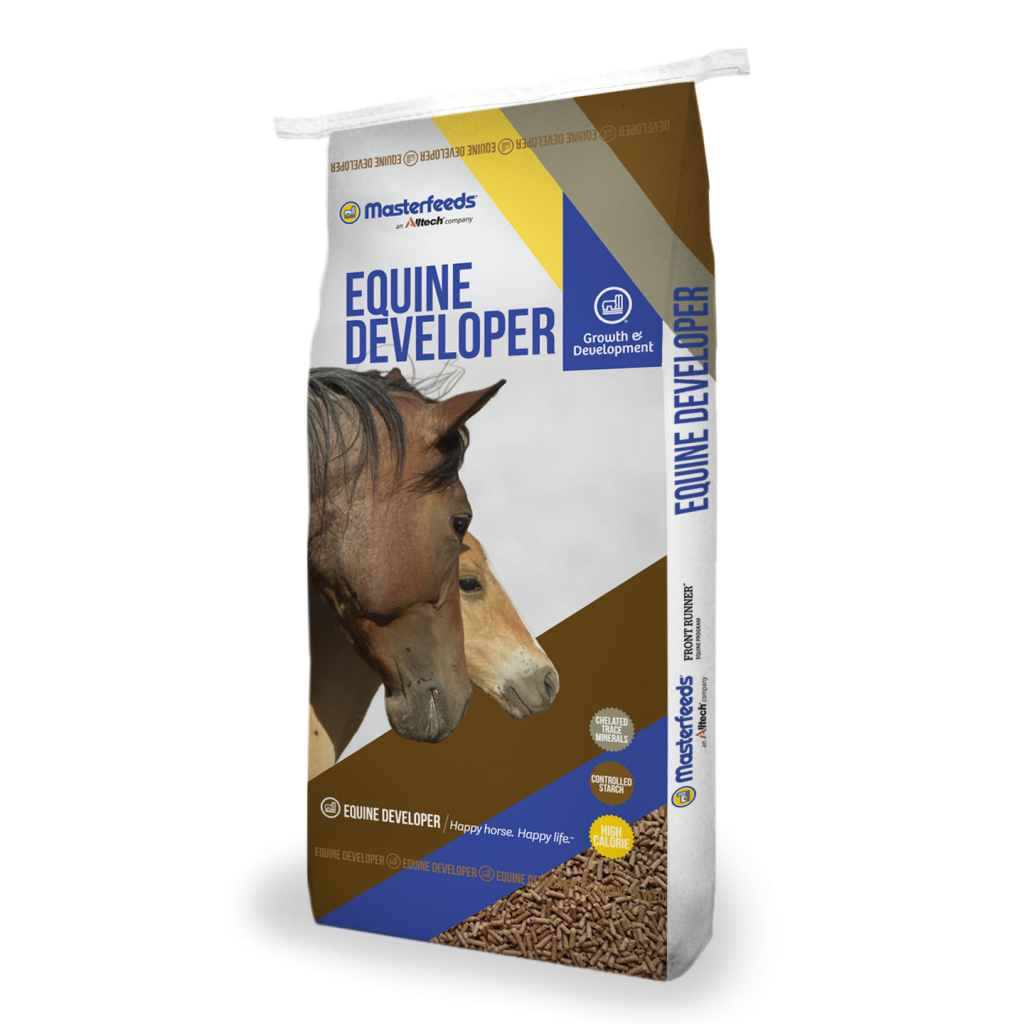
14% DEVELOPER (PELLET) EAST | WEST
FOR YEARLINGS, PREGNANT & LACTATING MARES
Masterfeeds 14% Developer is an excellent feed for broodmares, growing yearlings and two year olds. Well balanced protein, amino acids and energy levels, along with controlled starch content and premium mineral vitamin fortification, encourage balanced growth. The formulation is made to help reduce incidence of developmental problems. It is also an excellent choice for pregnant and lactating mares. The controlled starch content provides a safer choice for the mare, reducing risk for digestive upsets.
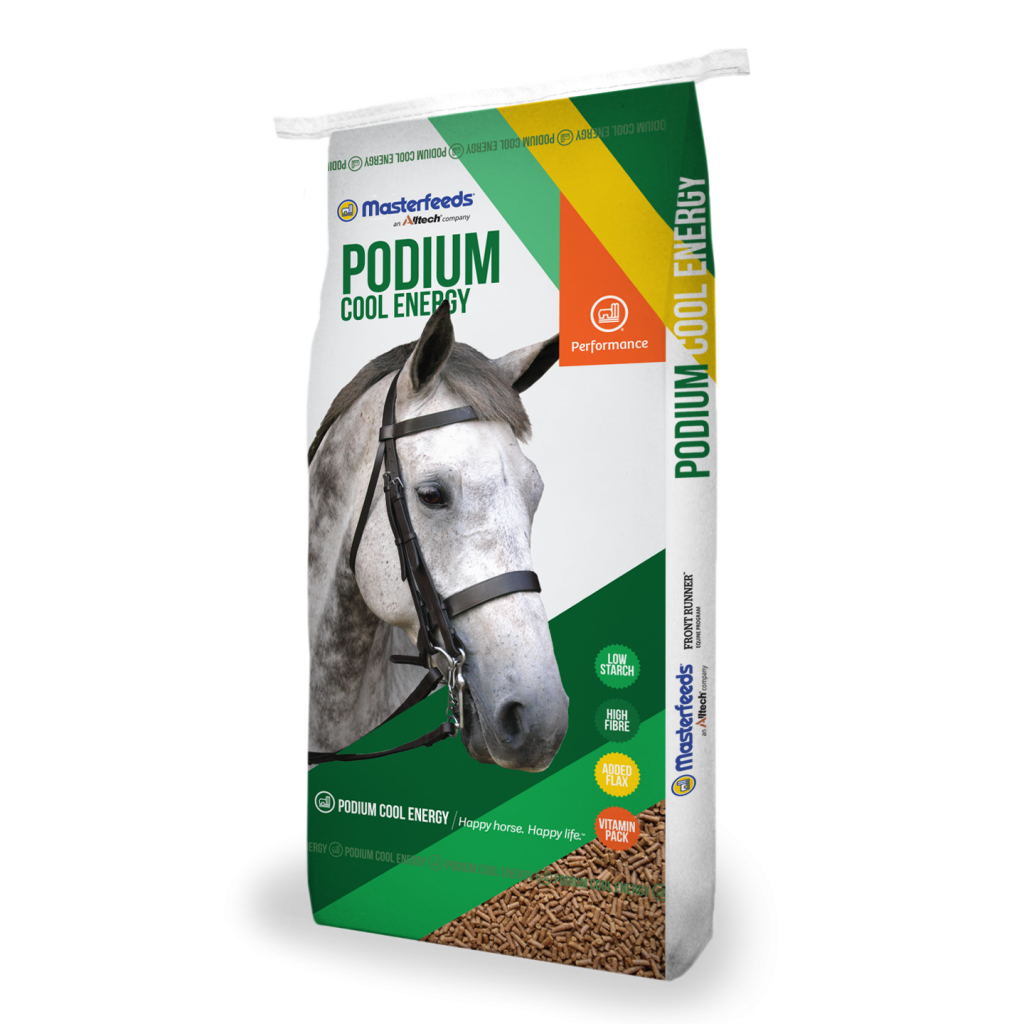
PODIUM COOL ENERGY (PELLET) EAST | WEST
FOR ALL TYPES OF EQUINE ATHLETES
Podium Cool Energy is a favourite with owners and trainers looking for a very low starch feed for high performance athletes. With proven results in reducing ulcer incidence and tying up, it is a great choice for standardbred racehorses, eventers, and any trainers and riders looking for an ultra low starch ration for working athletes.
Product Spotlight
- Winter Nutrition Tips
- Feeding the Mare and Foal
- Breaking Down Nutrition
- Spring Nutrition Tips
- Feeding for Performance
- All About Hay
- Feeding the Senior Horse
- Fall Nutrition Tips
- Feeding Supplements
- Economical Horse Management & Feeding Tips
- The Beginner’s Guide to the Equine Digestive System
- Feeding the Racehorse
- Feeding the OTTB
- Feeding the Active Senior
